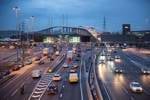Incorrect penalty notices, revenue figures falling short of expectations and businesses recording a slump in trade have marred the introduction of the charge.
However, a report published by Transport for London (TfL) this week has shown 65,000 fewer vehicles are entering the zone on a daily basis – a key weapon in Livingstone's defence of the scheme and an incentive for extending the zone further into other parts of London.
Livingstone said: 'Congestion charging was a radical solution to a long-standing problem. Before the introduction of the charge, London's roads were clogged with slow-moving traffic and congestion was costing business £2 million a week.
'The scheme has made a real difference in getting London moving again. Fewer vehicles in the zone coupled with improved bus services and faster, more reliable vehicle journeys make London a far better place to work, live and visit.
'Despite the dire predictions before the launch of the scheme, congestion charging has proved a success and that is why nearly three-quarters of Londoners now support the scheme – because it works.'
The report from TfL, 'Congestion Charging: Update on Scheme Impacts and Operations', outlines key points following the introduction of the scheme on February 17, 2003.
Malcolm Murray-Clark, congestion charging director at TfL, said: 'The report shows concerns over the effects on business are misguided and that negative perceptions are unsubstantiated. The public and business are acknowledging the benefits of the charging scheme. Nobody could have envisaged that the scheme would be such a success a year ago.'
The report surveyed 700 businesses inside and just outside the charging zone, with many contributing wider economic factors to a slump in business.
A spokesman at TfL said: 'Central London businesses were adversely affected by a number of factors in 2003.
'These included, first and foremost, the general economic slowdown in London last year, a fall in the number of tourists and other visitors tot the city, various seasonal factors and the closure of the Central Line during the first part of 2003.'
From those surveyed, 60% of businesses said they supported the congestion charge as long as there was continued investment in public transport. A fifth disagreed and a fifth said they did not know.
However, LeasePlan's subsidiary Fleetline, which provides vehicle management services to small and medium enterprises (SMEs), found a different story.
In a survey published by the group, only 18% of 250 businesses polled in London thought the congestion charge was good for business. David Harnett, director of Fleetline, said: 'With the majority of SMEs not perceiving any clear business benefits from the congestion charge and only 25% seeing road tolls as a solution to Britain's overcrowded roads, these statistics demonstrate that small and medium-sized businesses are not fully supportive of road charging.'
Despite grumbles from some inner city businesses, Livingstone is pushing ahead with plans to widen the scheme across London.
TfL began a 10-week consultation last week for the Mayor's proposals to extend the congestion charge zone.
The consultation will include a leaflet drop to more than three million households, 250,000 businesses and 1,400 stakeholders throughout London.
Livingstone wants to extend the scheme further across west London and if the consultation is a success, the scheme could be enforced by 2006.
Livingstone said: 'Cong-estion has been cut by almost a third in the central zone, yet it remains a problem in other parts of London. Other parts of Westminster and most of Kensington and Chelsea are more pressing cases for congestion charging, as their residents and businesses are subjected to congestion throughout the day.
'Extending the zone would help reduce this problem and bring yet more economic and financial benefits to London.'
TfL estimates that by extending the scheme, there would be 5% to 10% reduction in traffic and 10% to 20% reduction in congestion in the additional zone. The Government body has also set revenue expectations of up to £10 million from extending the zone, which it pledges will be invested in London's transport system.
Michele Dix, congestion charging director at TfL, said: 'This proposal would bring further benefits to London, its people and its economy.
'Although there are some concerns, it is the very purpose of this consultation to listen to them and to devise a scheme that would benefit all.'
Guilty as charged
Top 10 excuses given by company car drivers trying to avoid the congestion charge:
(Source: LeasePlan)
Other cities look at new schemes
OTHER UK cities are taking note of Livingstone's success with Edinburgh, Cardiff, Leeds, Manchester and Bristol all looking at similar schemes.
Edinburgh is considering introducing two congestion zones, an inner and an outer zone, each enforcing different levies. Motorists entering the inner zone – which is roughly that same size as the current London charging zone – would be charged £2 between 6.30am and 7pm.
Additionally, motorists entering the second zone, which would span 20 miles around Edinburgh would be charged between 7am and 10am.
Edinburgh is to hold a referendum later this year with the scheme proposed for 2006. Other cities are still at the tendering stage to introducing a charging scheme.
Review after fines blunder led to overpayment
TRANSPORT for London completed an audit review of Capita, the group in charge of the London congestion charge scheme, last July after it emerged cheques issued in payment for fines were not processed correctly. The blunder, due to a faulty printer, led to 350 drivers overpaying on fines which were issued after drivers failed to pay the initial congestion charge fee.
The following month TfL changed its contract with Capita. The group has now met its proposed objectives and the full programme of improvements should be completed by the end of next month.
Call for electronic signs after penalty surge
THE AA Motoring Trust has called on Transport for London (TfL) to provide electronic signs for motorists entering the congestion zone.
The trust said there had been a recent surge in penalties issued seconds before the charging hours ceased.
Paul Waters, head of roads and transport at the AA Motoring Trust, said: 'TfL should erect electronic 'zone on/zone off' signs on all approaches to the charging area, so drivers are in no doubt about whether they are safe to drive within the zone without being fined.'
An AA survey of 300 motorists around London has shown that 70% of motorists claim parking problems deter them from entering the capital, with only 45% being put off by the congestion charge.















Login to comment
Comments
No comments have been made yet.